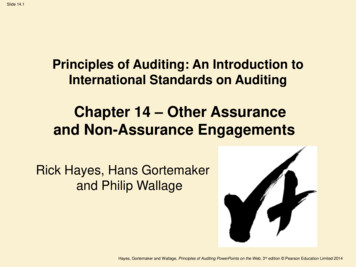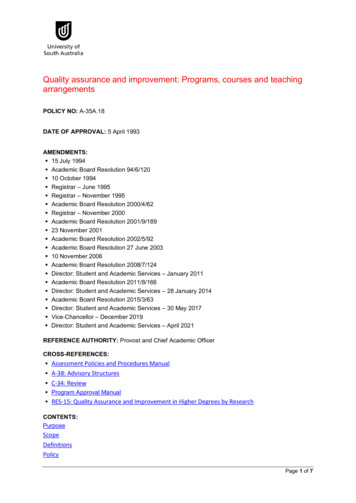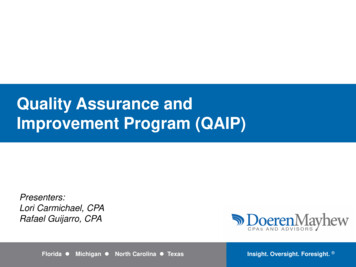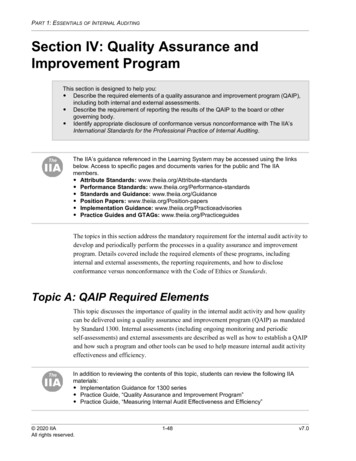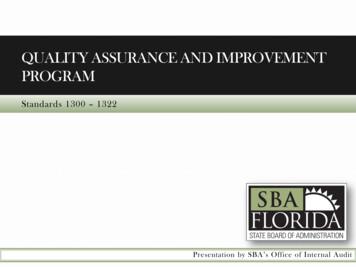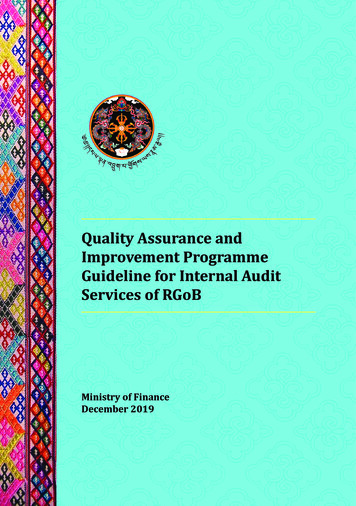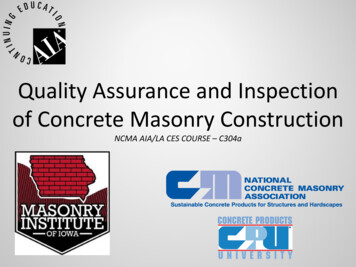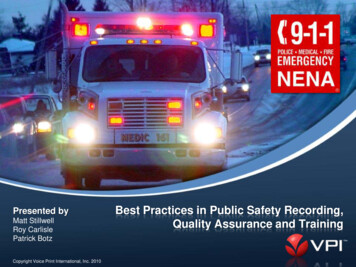
Transcription
Presented byMatt StillwellRoy CarlislePatrick BotzCopyright Voice Print International, Inc. 2010Best Practices in Public Safety Recording,Quality Assurance and Training
Today You’ll LearnIntroductionsKey Emergency Communications Trendsand DriversBest Practices in Recording, QualityAssurance and TrainingCity of Edmond, OklahomaAlachua County Sheriff’s Department, FloridaPreparing for the Future: Next Generation9-1-1 Recording and QA SolutionsPresentation slides available at:www.VPI-corp.com/Best-Practices2
Patrick Botz – VPIVPI (Voice Print International)100% US-based R&D and SupportServing some of the continent’slargest PSAPs for over 15 yearsPolice, Sheriff, Fire, ArmedForces, Emergency MedicalServices, Government Agencies2009 APCO Hot Product of theYearNENA and APCO MemberNext Generation9-1-1 ReadyGSA Approved
Matt Stillwell, ENP - City of Edmond, OKDirector, Central Communications/Emergency Mgmt – City of EdmondServes on FEMA Task Force forInteroperable Communicationssince 2007Florida APCO CommunicationsCenter Director of the Year, 2005
Public Safety at The City of Edmond, OklahomaPolice Department, Fire Department, 9-1-1Call Center and Emergency ManagementServices partner to provide the highest qualityservice and protectionFull-time recording:5 phone/radio positions,17 radio frequencies (Genesis)6 Talk Groups5 9-1-1 positions and trunks44 administrative VoIP linesSelective retention of recordings: 72 phone usersMotorola Statewide Radio System, TriTech CAD, CTI 911
Roy Carlisle – Alachua County Sheriff, FLAbout Roy CarlisleLaw Enforcement professional since 1983911 Operator – County Sheriff and PoliceFormer Shift Supervisor, Communications CommanderPresently in charge of QA program at Alachua CountyMajor contributor to APCO’s QA standards - to bereleased in 2010 as mandatory for APCO membersAbout Alachua CountyPopulation 227,120University of Florida fighting GatorsDiverse culture, local music, artisansE-911 under the direction of the County’s Fire/Rescue ServicesCity and County Emergency Dispatch MergedType 4 Enhanced 911 (E-911) systemANI/ALI, Selective Call Routing and Selective Transfer
Emergency Communications TodayCivilian PopulationGrowing Security ConcernsGreater Citizen DemandsIncreasing Laws and RegulationsRapidly Evolving TechnologyPSAPInteroperabilityNext Generation 9-1-1Support for:VoIP / HybridCommunicationsImagesVideoText alityAssurance &Ongoing TrainingAssure Protocols andProcedures are FollowedComply with Laws andRegulationsLimit Liability ExposureUnderstand andImprove “Soft Skills”Increase EmployeeRetentionCost & EfficiencyPressuresConsolidationDo More with LessResourcesAutomate Manual,Time ConsumingProcesses
Recording, QA & Training Best PracticesPresented by Matt Stillwell, City of EdmondCopyright Voice Print International, Inc. 2010
Recording and Incident RecreationRecord: public safety communications, utilitycustomer service center and telephone users in the cityUse secure Web interface to quickly access recordingsfrom anywhereRecordings stored for 7 years on network devices – majorimprovement over previous tapes and DVDsEasy to export, email and share recordings:Case Evidence – internal and for a DAShowcase best practice calls - training and inspirationRecordings with goofy callers to ease the atmosphereCase evidenceSingle calls“Real-time” sets of calls for incident recreation
Action Plan for Amber Alert CallsInvolved in APCO’s Amber Alert program since itsinceptionMissing & Exploited Children cases cause majorspikes in call volume into our 9-1-1 center – manypeople involvedBank of spare VoIP lines to be activated as neededto handle the sudden large influx of callsThe calls that come in on these VoIP lines arerecorded and evaluatedSlide 10
What to Look for in a Recording SystemOpen Architecture, standards-based hardwareCentralized storage of recorded communicationsSecure web based interface – unified access to allcalls from anywhereEasy to save and email filesOptions for flexible recording, retention on demand,and archiving rules where different user groups canhave calls retained for different length of timeMake sure your vendor understands the public safetyenvironment and the criticality of highly responsiveserviceSlide 11
Quality Assurance – New StandardsChair of the joint committee (APCO, NENA andothers) currently drafting the Standard for QAevaluationOn the fast track to become an ANSII CertifiedStandard - nearly completed nowThe Standard encompasses the entire QAprocess and will define what is acceptable for ourindustryExample: number of evaluations per month peremployee according to agency sizeSlide 12
Quality Assurance and TrainingEvaluate 18 employees5 calls per employee per month, selected randomlyDetailed QA rating forms for each call type in our centerObjective: more consistent service qualityBetter transparency with staffProgressive training method for newcomersOne-on-one and classroom training for experienced calltakers and dispatchersConsidering electronic personalized trainingFocus on individual needs and weaknesses
Recording, QA & Training Best PracticesPresented by Roy Carlisle, Alachua County SheriffCopyright Voice Print International, Inc. 2010
Recording and Incident RecreationFull time recording: 12 call taking positions, 4 lawenforcement, 3 fire, 3 teletype and 2 supervisor positionsplus 3 special event positions for backupCommunications technology:Tri-Tech CAD systemVesta phone systemMotorola 800 Mhz radio systemTurnover issues require higher attention to communications:retirees and 14 new hires in training, new-hire turnoverEasy access to recordings importantFast export of recordings for distribution / copy onto CDEvidentiary purposesQA & Training
Quality AssuranceAll employees who are recorded are also evaluated (QA)Average of 2 evaluations per employee per weekRandomly select calls from all call types in order to:Objectively assess compliance with policy / proceduresIdentify trendsProvide timely feedback for improvement – always positive toneOn-demand evaluations outside of a standard routineCustom for individuals & their skill developmentDeveloped 10 Commandments of Call TakingFolded into training and QA assessmentQA forms with scoring objectives customized for each typeof communication / center
QA Scoring ExampleLEA Call Taker – QA Categories:Case Entry (Incident Location, Call-back number, etc.)Choice of Chief Complaint (nature of incidentdetermined?)Call Processing (speed, prioritization, spelling, keyquestions asked, call processing commandments, etc.)Customer Service (assure caller of help sent, efficientcall time management, use of calming techniques,correct volume/tone of voice, etc.)Scoring / Grading rules:100% for the category Exemplary Grade90% or more CompliantLess than 90% Not CompliantSlide 17
Quality Assurance - TrainingFollow-up with Non-Compliant EmployeesMandatory tracking on QA forms:Supervisor: Written improvement action plan for every noncompliant sectionTrainer: Written feedback on every non-compliant section andtype of review/training that occurredEmployee: Written feedbackTraining methods:Corrections through remindersReinforce understanding of a policyTraining via Training Bureau or Training OfficerIn process of implementation:Include a quiz to be completed by employee once QA assessmentis processedPersonalized messaging to remind about policy, QA results, etc.
QA – Motivation & ResultsVast improvement in quality and compliancesince implementation of a formal QA programSuccessful motivation approachesShift start time - announce perks for best performersSupport competitiveness of call takers by presentingintraday performance statistics:Call volumes shown now on boardsQA scores planned to present on personalized tickers:Call Taker Ticker – plannedDispatcher Ticker - plannedSlide 19
Preparing for the Future: Key NG9-1-1Recording and QA ConsiderationsCopyright Voice Print International, Inc. 2010
What is Next Generation 9-1-1?NG9-1-1 is a system comprised of hardware, software,data and operational policies and procedures to:Provide standardized interfaces from call & message servicesProcess all types of emergency callsAcquire and integrate data useful for call routing and handlingDeliver the calls/messages/data to the appropriate PSAPsSupport data communications needs for coordinatedincident response & managementProvide a secure environment for emergency communications“Simply put, the 9-1-1 system has not kept up withtechnology and is badly in need of modernization.”- National Emergency Number Association
Architecture Goals for NG9-1-1 TechnologiesScalability – supports varying sizes of PSAPsand 9-1-1 authoritiesExtensibility – adoption of future technologies withoutreplacementReliability – redundant hardware, multi-pathconnectivity, no single point of failureConfigurability – adaptable to diverse PSAP and 9-1-1needsInteroperability – interfaces and communicates acrossvarious systems and networksOpenness – Uses open systems, standards andprotocols
Key Elements of Centralized NG9-1-1 Incident ManagementAudio and DataRecordingDigital, Analog and IPTelephones and RadiosSurveilanceVideoText Messagingand EmailConsole ScreenRecordingCAD / GIS / Mapping / AVLScreen AnalyticsIncident #s and Types, ACNCentralizedIncidentDataVideo UploadsImage UploadsDocumentUploads
The Power of Screen AnalyticsEasily Tag CAD Data and Events to RecordingsIncident IDIncident TypeIncident SeverityIncident StatusIncident ent Resolved
Key Elements of Centralized NG9-1-1 Incident ManagementAudio and DataRecordingDigital, Analog and IPTelephones and RadiosSurveillanceVideoText Messagingand EmailConsole ScreenRecordingCAD / GIS / Mapping / AVLScreen AnalyticsIncident #s and Types, ACNCentralizedIncidentDataVideo UploadsImage UploadsDocumentUploads
Best Practices for Incident Information SharingSave or Email File(s)Instant RecallBest PracticeTraining ClipsQualityAssuranceAudio with or withoutScreen VideoCentralizedIncidentDataEmail Web LinkSecure Login RequiredIncidentEvidencePackage
Integrated Quality Assurance and CoachingEvaluate targeted callsand entire incidents byincident type to determineadherence to the dispatchstandards and protocolsUse results to identifyareas which may require:Additional trainingSupplemental coachingAdditional resources
Questions and AnswersIf you would like more information, please contact us at:Phone: 1-800-200-5430Email: Info@VPI-corp.comWeb: www.VPI-corp.comPatrick BotzDirector of Public Safety SolutionsMarketingCorporate Headquarters160 Camino RuizCamarillo, CA 93012Direct:Email:800.200.5430 x 5214PBotz@VPI-corp.comwww.VPI-corp.com28You’ll receive 2 complimentaryresource guides:
Thank you!
Recording and Incident Recreation Full time recording: 12 call taking positions, 4 law enforcement, 3 fire, 3 teletype and 2 supervisor positions plus 3 special event positions for backup Communications technology: Tri-Tech CAD system Vesta phone system Motorola 800 Mhz radio system Tu





